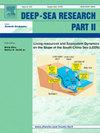Mesozooplankton community responses to environmental stressors in Kuwait's first marine protected area
IF 3
3区 地球科学
Q2 OCEANOGRAPHY
Deep-sea Research Part Ii-topical Studies in Oceanography
Pub Date : 2025-08-19
DOI:10.1016/j.dsr2.2025.105533
引用次数: 0
Abstract
Understanding mesozooplankton (MSP) dynamics in nursery habitats is crucial for assessing ecosystem health and trophic interactions, particularly in anthropogenically stressed yet ecologically significant areas, such as Sulaibikhat Bay – home to Kuwait's first Marine Protected Area (MPA) in the northwestern Arabian/Persian Gulf (NWG). This study examines MSP community dynamics and environmental interactions over 26 months (October 2018–March 2021) across five fixed stations, including sites influenced by desalination and sewage outfalls. Seasonal fluctuations in water temperature, salinity, and nutrients significantly influenced MSP community structure. Copepods dominated, with cyclopoids (Oithona spp.) peaking in summer and fall, while calanoids (Parvocalanus crassirostris, Acartia spp.) were more prevalent in winter and spring. The cyclopoid-to-calanoid ratio, a potential indicator of trophic shifts, varied significantly across seasons, with cyclopoids prevailing in warmer months. Diversity and dispersion patterns, assessed through Venn diagrams and PERMDISP analysis, revealed higher species turnover near polluted sites and greater stability within the MPA. Taxonomic relatedness indices (AvTD, VarTD) indicated reduced diversity in chronically stressed areas. BIOENV and RELATE analyses identified temperature, dissolved oxygen, turbidity, and nanophytoplankton chlorophyll a as key drivers of the MSP community. Significant negative correlations between fish larvae and cyclopoids near the Al-Ghazali sewer outlet suggested potential prey-predator interactions, reinforcing the ecological implications of MSP composition shifts in this nursery habitat. While the MPA supports high MSP diversity, ongoing stressors, such as brine discharge and sewage, continue to shape the MSP community and trophic interactions. This study provides critical insights for ecosystem-based management of marine resources in and around Kuwait's first MPA in the NWG.
科威特首个海洋保护区中浮游动物群落对环境压力的响应
了解苗圃栖息地中浮游动物(MSP)的动态对于评估生态系统健康和营养相互作用至关重要,特别是在人为压力较大但具有重要生态意义的地区,如Sulaibikhat湾——科威特西北阿拉伯/波斯湾(NWG)首个海洋保护区(MPA)所在地。本研究考察了五个固定站点26个月(2018年10月至2021年3月)的MSP社区动态和环境相互作用,包括受海水淡化和污水排放影响的站点。水温、盐度和养分的季节波动对MSP群落结构有显著影响。以桡足类为主,夏秋两季以圆足类(Oithona)居多,冬春两季以卡拉类(Parvocalanus crassirostris, Acartia)居多。作为营养转移的潜在指标,环样体与类callanoid比值在不同季节变化显著,在温暖的月份环样体普遍存在。通过维恩图和PERMDISP分析评估的多样性和分散模式显示,污染地点附近的物种流动率更高,MPA内的稳定性更高。分类相关性指数(AvTD, VarTD)表明,慢性应激区物种多样性降低。BIOENV和RELATE分析发现温度、溶解氧、浊度和纳米浮游植物叶绿素a是MSP群落的关键驱动因素。Al-Ghazali下水道出口附近的鱼类幼虫和cyclopoids之间存在显著的负相关,表明潜在的捕食者-捕食者相互作用,加强了该苗期栖息地MSP组成变化的生态意义。虽然海洋保护区支持MSP的高度多样性,但持续的压力因素,如盐水排放和污水,继续塑造MSP群落和营养相互作用。这项研究为基于生态系统的海洋资源管理提供了重要的见解,这些海洋资源管理是科威特在NWG的第一个海洋保护区。
本文章由计算机程序翻译,如有差异,请以英文原文为准。
求助全文
约1分钟内获得全文
求助全文
来源期刊
CiteScore
6.40
自引率
16.70%
发文量
115
审稿时长
3 months
期刊介绍:
Deep-Sea Research Part II: Topical Studies in Oceanography publishes topical issues from the many international and interdisciplinary projects which are undertaken in oceanography. Besides these special issues from projects, the journal publishes collections of papers presented at conferences. The special issues regularly have electronic annexes of non-text material (numerical data, images, images, video, etc.) which are published with the special issues in ScienceDirect. Deep-Sea Research Part II was split off as a separate journal devoted to topical issues in 1993. Its companion journal Deep-Sea Research Part I: Oceanographic Research Papers, publishes the regular research papers in this area.

 求助内容:
求助内容: 应助结果提醒方式:
应助结果提醒方式:


